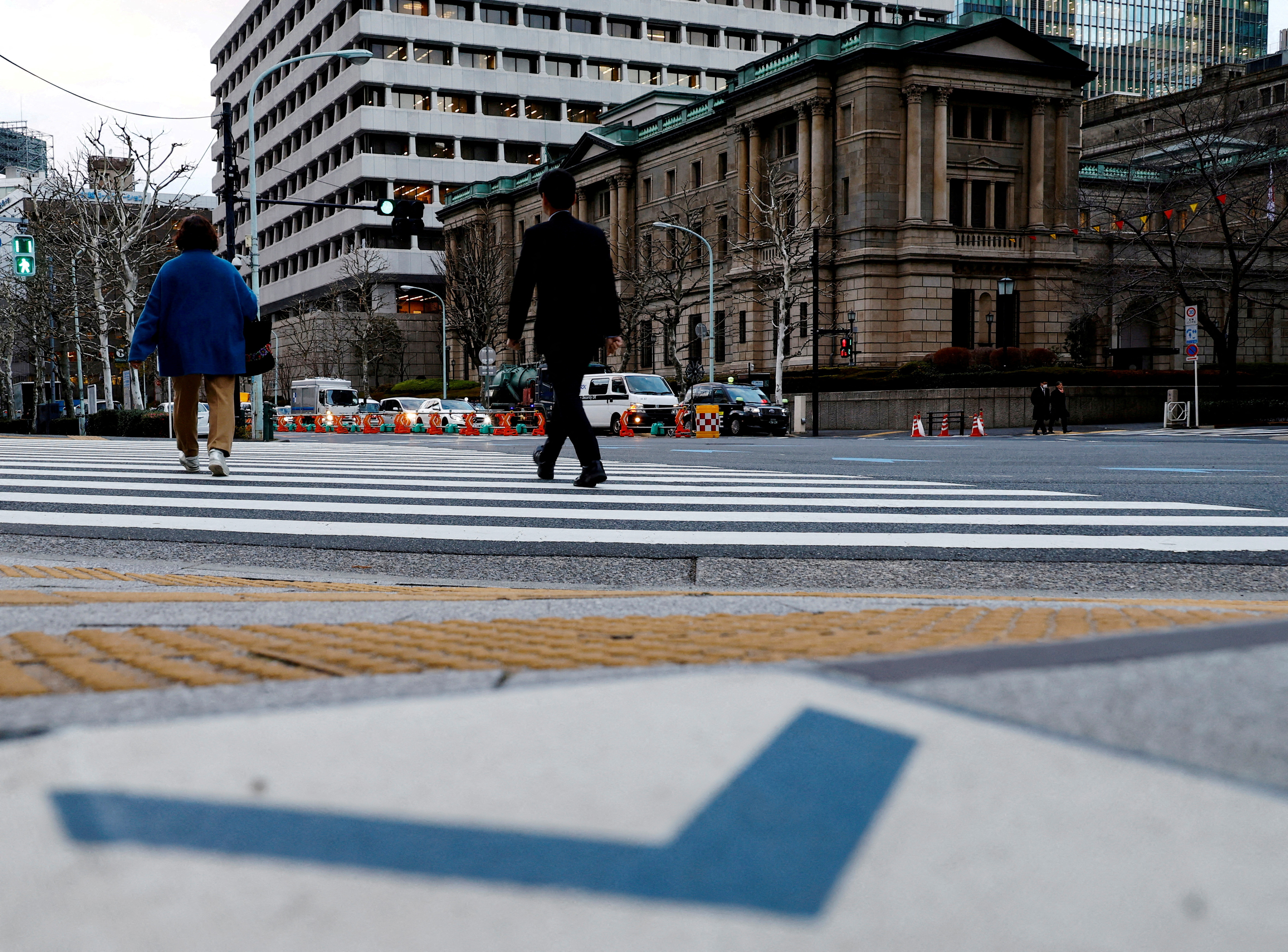People walk past Japan’s national flags in a shopping district in Tokyo, Japan March 19, 2024. REUTERS

Pedestrians walk past the Bank of Japan building in Tokyo, on March 18, 2024. REUTERS

People walk in front of the Bank of Japan building in Tokyo, Japan January 23, 2024. REUTERS
TOKYO, March 19 (Reuters) – The Bank of Japan (BOJ) ended eight years of negative interest rates and other remnants of its unorthodox policy on Tuesday, making a historic shift away from a focus on reflating growth with decades of massive monetary stimulus.
While the move was Japan’s first interest rate hike in 17 years, it still keeps rates stuck around zero as a fragile economic recovery forces the central bank to go slow in any further rise in borrowing costs, analysts say.
The shift makes Japan the last central bank to exit negative rates and ends an era in which policymakers around the world sought to prop up growth through cheap money and unconventional monetary tools.
“The BOJ today took its first, tentative step towards policy normalisation,” said Frederic Neumann, chief Asia economist at HSBC in Hong Kong.
“The elimination of negative interest rates in particular signals the BOJ’s confidence that Japan has emerged from the grip of deflation.”
In a widely expected decision, the BOJ ditched a policy put in place in 2016 that applied a 0.1% charge on some excess reserves financial institutions parked with the central bank.

The BOJ set the overnight call rate as its new policy rate and decided to guide it in a range of 0-0.1% partly by paying 0.1% interest to deposits at the central bank.
The central bank also abandoned yield curve control (YCC), a policy that had been in place since 2016 that capped long-term interest rates around zero.
The video player is currently playing an ad. You can skip the ad in 5 seconds with a mouse or keyboard
But in a statement announcing the decision, the BOJ said it will keep buying “broadly the same amount” of government bonds as before and ramp up purchases in case yields rise rapidly.
The BOJ additionally decided to discontinue purchases of risky assets like exchange-traded funds (ETF) and Japanese real estate investment trusts.
“We judged that sustainable, stable achievement of our price target came in sight,” the central bank said in a statement explaining the decision to dismantle former Governor Haruhiko Kuroda’s massive stimulus program.
With inflation having exceeded the BOJ’s 2% target for well over a year, many market players had projected an end to negative interest rates either in March or April.

In a sign any future rate hike will be moderate, the BOJ said in the statement that it expects “accommodative financial conditions will be maintained for the time being.”
The language compared with the more dovish guidance that was removed from the statement, in which the BOJ pledged to ramp up stimulus as needed, and keep increasing the pace of money printing until inflation stably exceeded 2%.
Japanese shares were volatile on Tuesday. The yen fell to almost 150 per dollar, as investors took the BOJ’s dovish guidance as a sign the interest rate differential between Japan and the United States likely will not narrow much.
Markets are now focusing on Governor Kazuo Ueda’s post-meeting news conference for clues on the pace of further rate hikes.
The stakes are high. A spike in bond yields would boost the cost of funding Japan’s huge public debt which, at twice the size of its economy, is the largest among advanced economies.
An end to the world’s last remaining provider of cheap funds could also jolt global financial markets as Japanese investors, who amassed overseas investments in search of yields, shift money back to their home country.
Under previous Governor Kuroda, the BOJ deployed a huge asset-buying program in 2013, originally aimed at firing up inflation to a 2% target within roughly two years.
The central bank introduced negative rates and YCC in 2016 as tepid inflation forced it to tweak its stimulus program to a more sustainable one.
As the yen’s sharp falls pushed up the cost of imports and heightened public criticism over the demerits of Japan’s ultra-low interest rates, however, the BOJ last year tweaked YCC to relax its grip on long-term rates.
Get a look at the day ahead in Asian and global markets with the Morning Bid Asia newsletter.
Reporting by Leika Kihara. Editing by Sam Holmes.


























![https___cloudfront-us-east-2.images.arcpublishing.com_reuters_SK2MTLI4ABNURCFWFBMDKIUAIM[1]](https://asiannewsindia.com/wp-content/uploads/2024/03/https___cloudfront-us-east-2.images.arcpublishing.com_reuters_SK2MTLI4ABNURCFWFBMDKIUAIM1-696x558.jpg)








